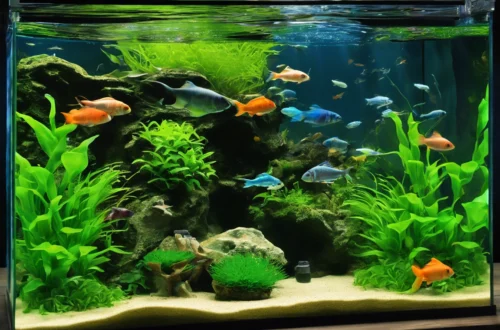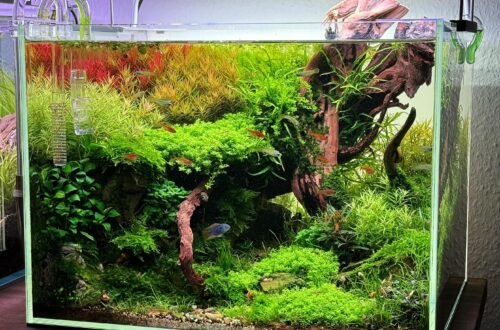Keeping your aquarium clean and healthy doesn’t have to be overwhelming. In fact, setting aside just a little bit of time each week for maintenance can make a huge difference in the well-being of your fish and the overall appearance of your tank. Trust me, when I first started out, I thought keeping an aquarium was a lot of work. But once I got into a weekly routine, I realized it’s pretty easy and even fun!
If you’re looking for a simple, step-by-step guide to keeping your tank in top shape, you’re in the right place. I’ll walk you through everything you need to do for weekly aquarium maintenance, from cleaning the glass to checking water quality. Plus, I’ll throw in some helpful tips and tricks I’ve picked up along the way. Let’s get started!
Why Weekly Maintenance Is Important
Before we jump into the steps, let’s talk about why weekly maintenance is so important. Aquariums are closed ecosystems, which means waste, uneaten food, and plant debris don’t have anywhere to go. Without regular upkeep, this can lead to poor water quality, algae growth, and even sick fish. By sticking to a weekly maintenance schedule, you’ll keep the tank environment clean and stable, helping your fish stay healthy and happy.
For more detailed information on water quality and fish health, you can check out Understanding Water Chemistry in Aquariums.
Step 1: Check Water Parameters
The first thing I always do when I start my weekly maintenance is test the water. This might sound complicated, but it’s really simple with an aquarium water testing kit. You’ll want to check key parameters like ammonia, nitrites, nitrates, and pH levels. This gives you a snapshot of the tank’s overall health.
- Ammonia and Nitrite: Both should be at zero. If they’re present, something’s off with your tank’s filtration.
- Nitrate: Should stay under 20-40 ppm, depending on the type of fish you have. High nitrates can stress your fish and encourage algae growth.
- pH: Keep an eye on it to make sure it’s within the ideal range for your fish species.
If you don’t have a test kit yet, here’s a good one to get started: Best Water Test Kits for Aquariums.
Step 2: Clean the Glass
Algae tends to build up on the glass, especially if your tank gets a lot of light. Cleaning the glass not only keeps your tank looking crystal clear, but it also prevents algae from getting out of hand. I use an algae scraper or a magnetic cleaner for this—it’s super easy and only takes a few minutes.
- For a magnetic cleaner, just move it along the inside of the glass, and it will scrub off any algae.
- If you prefer an algae scraper, be gentle to avoid scratching the glass.
Step 3: Prune and Clean Your Plants
If you’ve got live plants in your aquarium, part of your weekly maintenance should include trimming any dead or yellowing leaves and checking for algae. Plants can also shed debris that sinks to the bottom of the tank, which you’ll want to remove during your cleaning.
- Use aquarium-safe scissors to trim plants.
- If algae are starting to grow on the leaves, consider adding some algae eaters like Amano shrimp or Otocinclus to help keep things under control.
Step 4: Perform a Partial Water Change
One of the most important steps in weekly aquarium maintenance is performing a partial water change. This helps remove built-up nitrates, dissolved organic matter, and other pollutants. The general rule of thumb is to change about 20-30% of your tank’s water each week.
Here’s how I usually do it:
- Turn off your filter and heater to avoid damaging them during the water change.
- Use a gravel vacuum or siphon to remove water from the tank while also cleaning the substrate (gravel or sand). This removes debris like uneaten food and fish waste from the bottom of the tank.
- Replace the old water with dechlorinated tap water that’s the same temperature as your tank. I usually let the new water sit for a few minutes before adding it back in to make sure it’s conditioned properly.
For more on how to do water changes like a pro, check out How to Perform a Perfect Water Change.
Step 5: Rinse Filter Media (If Needed)
Now, you don’t need to clean your filter every week, but it’s a good idea to check it during your maintenance routine. If you notice the water flow has slowed down or the filter looks clogged, it might be time to give the filter media a quick rinse.
But here’s a pro tip: Never rinse your filter media under tap water! Tap water contains chlorine, which can kill the beneficial bacteria in your filter that help break down waste. Instead, use some of the old tank water you just removed during your water change to gently rinse the filter media. This keeps the good bacteria alive and your filter functioning properly.
For more detailed instructions, here’s a great resource: How to Clean Your Aquarium Filter.
Step 6: Top Off the Water Level
After performing the partial water change, you might notice the water level is a little lower. Simply top it off with dechlorinated water to get it back to where it should be. This step is super quick and helps maintain the right balance in your tank.
If you live in an area where water evaporates quickly, you may need to top off the water a bit more often, especially during the warmer months.
Step 7: Clean Equipment and Decorations
It’s also a good idea to take a look at your equipment and decorations during your weekly maintenance. If you notice any algae buildup on your heater, filter intake, or decorations, give them a gentle scrub using an aquarium-safe brush or sponge.
For decorations like rocks or fake plants, you can remove them from the tank and rinse them under tank water (never tap water, as it can introduce harmful chemicals). Just be careful not to disturb any fish or invertebrates that might be hiding among the decorations.
Step 8: Monitor Fish Health and Behavior
Finally, spend a few minutes just observing your fish. This is the best part of the routine for me because it’s a chance to see how everyone’s doing. Check for any signs of illness, like white spots, fin rot, or unusual behavior (like hiding or gasping at the surface). If something seems off, you can catch it early and treat the issue before it gets worse.
Here’s a great guide to recognizing common fish diseases: Fish Diseases and How to Treat Them.
Step 9: Update Your Aquarium Journal
If you’re really serious about aquarium keeping (or just love to stay organized), consider keeping a journal of your tank’s maintenance. You can log water parameters, water changes, plant trimming, and any notable fish behavior. It sounds like a lot of work, but it’s actually a fun way to track your tank’s progress over time. Plus, it can help you spot trends that might indicate potential problems.
Step 10: Enjoy Your Clean, Healthy Tank!
That’s it! With just a little time and effort each week, you can keep your aquarium looking beautiful and your fish living in a clean, stress-free environment. Regular maintenance helps prevent major problems down the road and makes the hobby so much more enjoyable.
Conclusion
Aquarium maintenance doesn’t have to be time-consuming or difficult. By sticking to a simple weekly routine, you can easily keep your tank in top shape, ensure a healthy environment for your fish, and reduce the risk of algae or water quality problems. From water changes to checking equipment and watching your fish, each step plays a key role in creating a balanced and thriving aquarium.
If you’re looking for more tips and in-depth guides, check out Aquarium Care 101 for all the information you need to maintain a happy, healthy tank.
FAQs
1. How often should I clean my aquarium filter?
You don’t need to clean the filter every week—typically, once a month is fine. Just make sure to rinse the media in tank water and never tap water to preserve beneficial bacteria.
2. What’s the best way to prevent algae growth?
Regular water changes, proper lighting, and keeping nitrate levels in check are key. You can also add algae-eating fish or invertebrates like Amano shrimp or Nerite snails to help control algae naturally.
3. How long should my aquarium lights be on each day?
A good rule of thumb is to keep your lights on for about 8-10 hours per day. Too much light can encourage algae growth, while too little can affect plant growth.
4. Can I use tap water in my aquarium?
Yes, but make sure to treat it with a water conditioner that removes chlorine and chloramines. These chemicals are harmful to fish and beneficial bacteria.
5. How do I know if my fish are healthy?
Healthy fish are active, have vibrant colors, and regularly eat. Watch for any signs of disease, such as white spots, clamped fins, or erratic swimming. Regular observation during maintenance helps you spot issues early.






